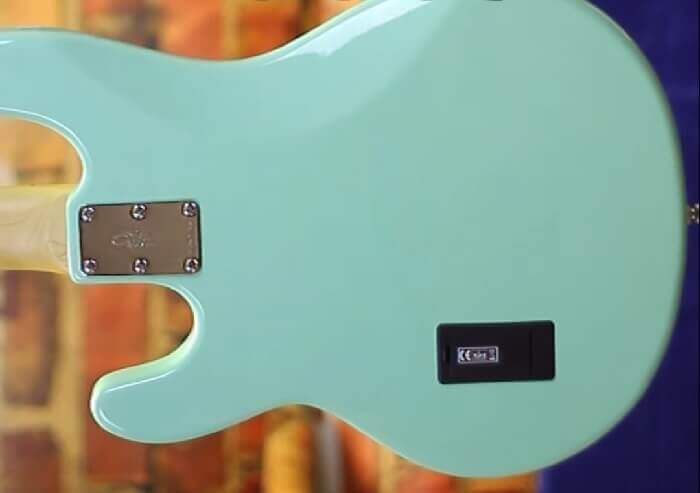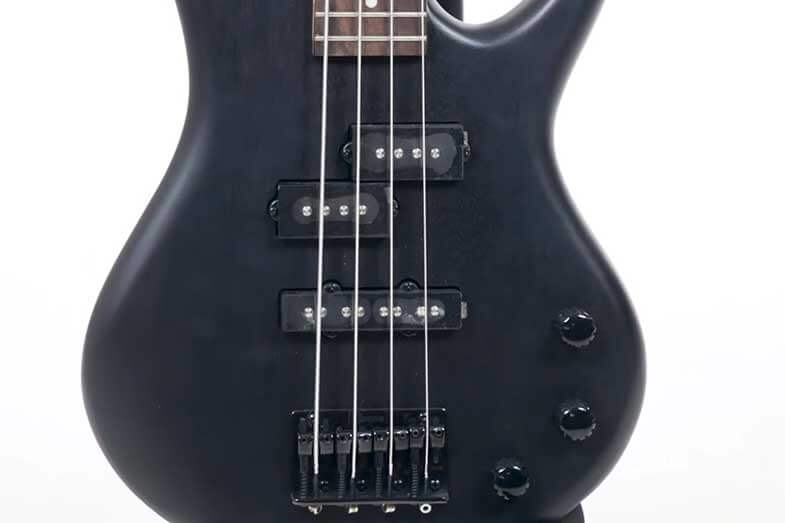When searching for the right bass guitar, there are many factors to consider. One of these factors is whether the bass should be active, passive, or both? What is the difference between them? Which one is better? In this article, I’ll explain the difference and give my recommendations.
Active vs passive bass guitar: what’s the difference? Which one is better? An active bass guitar requires a battery, and a passive bass guitar does not. An active bass guitar allows you to cut the tone, and a passive bass guitar does not. The best of both is to get a combination active/passive bass guitar that switches automatically to passive-mode if the battery dies.
Active bass guitars require a battery, often a 9-volt, in addition to being plugged into an amp. This is because they have built-in preamp (pre-amplifier) circuitries that enhance the output from the pickups and enforce control over the shapes of the tones. Passive bass guitars are simpler; they don’t require a battery and only need to be plugged in.
Read on to learn more about the differences between active and passive bass guitars, as well as which is better.
Also, for an excellent combination active/passive bass guitars, take a look at our top pick, the Yamaha TRBX604 4-String Flamed Maple Bass Guitar:
Click here to see it on Amazon.
Active Bass vs. Passive Bass: What Are the Differences?
| ACTIVE: | PASSIVE: | |
| Battery: | Needs battery to operate | No battery required to operate |
| No. of controls: | Fewer | More controls |
| Control over tone-shaping: | More control | Less control |
| Tone controls: | Can boost & cut frequencies | Can only cut frequencies |
| Flexibility: | More flexible | Less flexible |
| External Noise: | Picks up lesser noise | Picks up more noise |
| External Interferences: | Picks up lesser interference | Picks up more interference |
| Signal: | Stronger | Weaker |
| Dynamic sound: | Not so dynamic, but bright and snappy tones | More full, dynamic, and round tones |
| Output: | Louder | Softer |
| Electrical maintenance: | Requires more | Requires lesser |
In this video by Hugh Richardson, you’ll learn more about the difference between active and passive bass guitars, as well as hear how each sounds.
Ideally, it is best to have an active and a passive bass if you have the money; or, there are combination active/passive bass guitars, such as the Yamaha TRBX 500 or 600 Series that have a kill switch. In case the battery dies, a combination active/passive bass guitar automatically switches to passive-mode.
Click here to see it on Amazon.
What Is an Active Bass and Its Features?

As mentioned previously, the active bass uses a preamp (pre-amplifier) circuitry that enhances the output from the pickup and enforces control over the shapes of the tones.
The active bass operates with a battery, often one or two 9-volt batteries, in addition to being plugged into the amp. If the batteries are dead or if there are no batteries in an active bass, there will be no sound, even if the guitar is plugged into an amp.
So be prepared with extra batteries so that you’re ready if on tour or heading out to a gig when your guitar dies. It will also take a few minutes to change the batteries because you have to loosen the screws.
It could spell disaster for you and your group if your performance is ruined due to your lack of preparation. To avoid this from happening, always check your batteries before leaving for the performance venue.
Or, some bassists have a backup bass just in case, e.g., a backup passive bass that you’ll never have to worry about as it doesn’t have batteries.
Batteries can last from one week to a month, depending on how often you play your bass guitar. To save energy, unplug the guitar from the amp when not in use.
As for the equalizer, the active bass equalizes the signal coming from the pickups before it reaches the output jack. It has more electronics as compared to the passive bass, such as a separate EQ, more controls, a preamp, and a power source.
With active basses, it doesn’t really matter how long the cable length is as the preamp power source in the active bass buffers the output. With passive basses, a longer cable can mean lower signal strength.
Active Bass Guitar Features
Battery and Preamp
The preamp operates using on-board, 9-volt batteries, or an 18-volt system. Without the battery, you won’t be able to play the active bass.
Some bass guitars have both the passive and active bass, allowing you to switch from one type to another as required by whatever situation you’re in.
Choosing bass guitars with both active and passive functions would be beneficial to bass players who are always active in performing and may not have the chance to change batteries.
Feedback Controls
The feedback controls are used to reduce or increase sounds.
Pickups
This can be split pickups or a single pickup. As the term implies, they ‘pick up’ the vibration created by the instrument.
EQ Controls
EQ controls on an active bass are divided into specific frequency bands, such as high, mid, and low. They control the level of treble, bass, or mid sounds and sounds from various frequencies. This will allow you to modify your bass to sound the way you want to.
Output jack
The output jack is a physical connector between the bass guitar and the amplifier.
To put things in greater perspective, here are the pros and cons of active bass guitars.
Active Bass Pros
- Tones can be shaped the way you want to.
- Provides more flexibility in cutting and boosting tones.
- Better tonal control with a variety of control choices.
- Lesser interferences and noise from external sources.
- Can use longer cables without worrying about loss of signal strength.
- Sounds can travel quite a distance without sound distortions due to presence of power source.
- Enhances performances as you can explore a number of varied tonal landscape within your set list.
Active Bass Cons
- More circuitry and parts means more things that could break down over time.
- Have to always ensure batteries are fully charged, especially near performances.
- If controls aren’t set right, they can produce unwanted noise.
Recommended Active Bass
The Sterling by Music Man StingRay Ray4 is a very affordable and great-sounding active bass guitar. Music Man is one of the most recognized guitar brands in the U.S. This bass has the iconic StingRay shape, a2-band active preamp, and comes in a variety of colors.
Click here to see it on Amazon.
What Is a Passive Bass and Its Features?

The passive bass is similar to the active bass in that it equalizes and boosts the pickup signal before it reaches the output jack. But its function is limited only in boosting the tones and is not able to cut them.
The passive bass has similar features to that of the active bass, but with a few modifications, such as the battery and the EQ (Equalization). Passive basses don’t require a separate EQ, as the volume and tone controls can function as such.
The sound produced by a passive bass is more dynamic because how you play the guitar would come out as is. If you play the bass guitar softly, the sound will come out softer, and vice versa. In the case of active basses, the sound will come out the same (normalized) no matter how you play the instrument.
Passive Bass Features
Feedback Controls
Feedback controls are used in reducing or increasing sounds.
Pickups
Generally, passive basses have single pickups. It has the same function as the pickups in active basses.
Output Jack
A physical connector between the bass guitar and the amplifier.
To put things in greater perspective, here are the pros and cons of passive bass guitars.
Passive Bass Pros
- Easy to manipulate because of simpler circuitry
- Purer sound as it uses fewer circuitry
- Ideal for beginners
- Easier to play due to fewer controls
- No need for batteries, so no performance disruption due to battery failure
Passive Bass Cons
- Weaker signals
- When using long cables, noise and external sounds can interfere with signal strength
- Does not support a variety of tones
Recommended Passive Bass
The Ibanez GSRM20BS 4-String Bass Guitar is one of my favorite bass guitar recommendations for beginners. The neck is skinnier than most, so it’s easy for small hands to grip around. It is a passive bass, so it doesn’t give the option to cut the tone; however, there will be no stressing about having to replace any batteries.
Click here to see it on Amazon.
Active vs. Passive Bass: Which One Is Better for Beginners?
Active vs passive bass: which one is better for beginners? The passive bass is recommended for beginners because it’s less complicated. It has fewer controls and fewer active electronics but serves its purpose. It can play well-rounded bass guitar riffs with a pure, simple sound. Simply put, passive bass guitars are usually plug-and-play instruments.
Beginners would not be lost in the complexity of the tone controls, as there are only volume and tone controls that they can tweak, instead of various micro-switches and a circuit board that can confuse even the pro bass guitar players.
But, if you’re a beginner, who wants to try the active bass guitar, then go ahead and do so. Nothing is stopping you from finding out for yourself what’s best for your own music.
In contrast, the active bass offers more active electronics that a professional can explore while creating their masterpiece. The active bass guitar can harness your creativity and further hone your musical skills in playing it.
You can experiment and fiddle with the different controls to find out how each control can improve your output. Think of the active bass guitar as your playground in finding the intricate pleasures of toying with your music.
Nonetheless, many professionals may prefer the passive bass due to the type of music they play. So, it would depend too on the bass guitar player’s purpose and music genre.
Which Is Better: Active or Passive Bass Guitar?
Should you choose the passive or the active bass guitar? The above-mentioned information are my recommendations, but, in the end, it’s still you who will make the final choice. What should you take into consideration in choosing your bass guitar – between passive and active?
Experience Level
I will provide some tips that you may want to use in this process. Obviously, you would have to consider your level of expertise in playing the bass guitar. Are you an expert or a beginner? Determine your level of competency and refer to the information above.
If you’re a professional bassist, who is in a band, most probably you would pick the active bass. Nonetheless, there’s another awesome option for you: to select a bass guitar that features both the active and passive bass. This way, when your battery dies in the middle of your leg-breaking performance, your passive bass could kick in. You could smoothly transition from an active bass to a passive bass set-up.
This is an easier strategy rather than changing the battery as you will have to open up the guitar’s interior, which can be time-consuming. It’s also easier than having to reach around and grab a backup passive bass guitar as many bassists have in an emergency.
Purpose
What’s your purpose in purchasing a bass guitar? If you simply want to learn how to play and accompany your songs, settle for the less complex bass – that is, your passive bass guitar.
You wouldn’t want to spend hundreds of dollars on a musical instrument that you barely know how to play, would you? Yes, the active bass guitars are more expensive than the passive types. It’s because they have a number of electrical circuitry needed for their proper operation.
It would be wise, to start slowly with a passive bass guitar, and then gradually level up your musical instrument as you gain additional skills. That could be a perfect time to swap your passive for an active bass guitar or a combined passive/active guitar.
Once you’re more experienced, you’ll have a better grasp of the sound you want. You’ll then be able to decide whether you want to get a more complex, albeit more feature-rich, active bass; or stick with a simpler passive bass.
Cost
You may wish to have the latest model bass guitar, whether active or passive, but you don’t have enough finances. There are cheaper active basses, just as there are more expensive passive basses.
The Yamaha TRBX 500 or 600 Series has a combination active/passive circuit for extreme flexibility and fine tonal control. In my opinion, this is my personal favorite choice. If the battery dies, the guitar automatically changes to passive-mode.
Click here to see it on Amazon.
The Yamaha TRBX comes in 4-string or 5-string, plus a wide range of colors, all at great value compared to more premium active/passive combination bass guitars.
Conclusion – Active vs Passive Bass
So to recap, active vs. passive bass: what are the differences? Which one is better? The main difference between the two is that active bass guitars require a battery as they have a built-in preamp that you can use to boost or cut the signal. Passive bass guitars don’t require a battery; you just plug it in.
Which one is better would vary from one person to another. This would depend on several factors, such as the purpose, level of expertise, cost, and preferences.
I generally recommend passive bass guitars for beginner bassists and the active bass guitar for professional players. However, if you have a bit more money to spend, and feel confident that you will be committed to improving your skills, anyone, whether beginner or pro, will benefit from a combination active/passive bass like the Yamaha TRBX series I listed above.
Feel free to make your own choice. You make the call on the type of bass guitar – between passive, active, or combination – you would want to play.
Related reading:
What Do Bassists Think Are the Best Bass Guitars?
What Is the Best Bass Guitar for Small Hands?
7 Best American-Made Bass Guitars












![Rap Songs with Good Bass [Best 15 Songs] rap songs with good bass](https://musicalinstrumentpro.com/wp-content/uploads/2021/10/rap-songs-with-good-bass-150x150.jpg)


